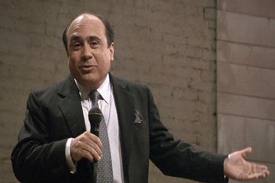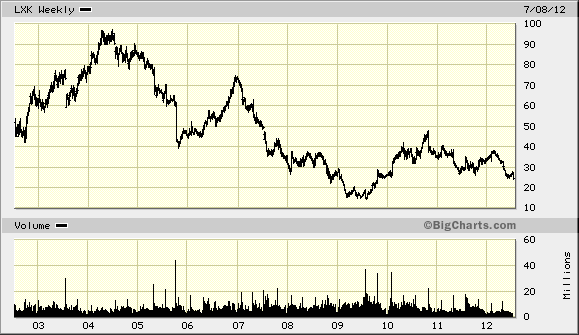
JC Penny’s (JCP) Announces Terrible Earnings but The stock rallies

Is the market a discounting mechanism? Jim Cramer of CNBC would say, “JCP is a CROWDED short.” The beginnings of a case study here: JCP_Barrons
Scams
My inbox is being flooded (as a subscriber–to find shorts–to Penny Stock Newsletters my email is raw meat for scammers) with more sophisticated scams: IMF_–_International_Monetary_Fund_SCAM
My email automatically responds to the scammer to call about 50 different (phony) phone numbers in the US to reach me so I can wire funds to help them.
Portfolios
Beyond Buffett_Aug 12 (The old Harry Browne Method of Asset Diversification)
Note: Charlie Munger once said that no one ever got rich being an asset allocator.
Updated: Aug. 13, 2012: from www.economicpolicyjournal.com
The economist and financial author Harry Browne once designed what he
called a “Permanent Portfolio”. The idea behind PP was to create a
portfolio in away that investments were made so that the portfolio
would maintain its value and grow conservatively over time, with
certain parts of the portfolio outperforming other parts of the
portfolio at different times, depending upon the economic
environment—without having to time the economy.
Browne’s idea was to equally divide up a certain amount of money
between various sectors. Because he felt the economy was cyclical, he
felt that when a sector was cheap (and might be poised for a climb)
you would end up buying more unit wise in that sector, if you
allocated your money equally among the sectors, and less, unit wise,
when prices were higher, BUT that this still resulted in your
participating in all sectors, without having to attempt to time the
exact ups and downs of the business cycle.
There’s a lot to be said for Browne’s PP.
His four sectors were:
The US stock market via warrants
The 30-year T-bond.
Gold coins.
Cash, i.e.,Treasury bills
This is a good base to work with. However, given that the yield on the
30-year Treasury bonds is so low (2.65%), in my view it makes no sense
to put money in them. Thus, I would put money into only three sectors:
gold coins, Treasury bills and the US stock market.
As far as gold coins are concerned, I would divide up purchases
between both gold coins and silver coins. And also, if your back is
strong enough, nickels.
Put 33% in nickels of your “gold sector” purchases. They can be
acquired at any bank. Put 33% in gold coins and 33% in silver coins.
Buy only what is known as “junk silver” (These silver coins come in
bags of $1,000 face value). as for gold buy only “bullion coins” such
as the American Eagle and Canadian Mapleleaf.
If you do not live near a major gold coin dear that has been in
business for at least a decade, consider buying from Kitco.I have
successfully purchased coins via mail with Kitco for many years. If
you chose to use a different dealer, you can use the Kitco prices
online as a guide. One note when buying online, split up your order,
so you don’t risk having an order lost. It’s very unlikely an order
will get lost but take the precaution and split you order up.,Kitco
sends by registered mail and they video tape every step of your coin
order as it is put in a box.
As for Treasury bills, depending upon the size of your purchase, you
can buy them directly from the Fed or through a bank or broker.When
possible, I recommend dealing directly with the Fed.
For those dealing in smaller numbers, I recommend simply using a bank
account at a “Too Big To Fail” bank.
Browne recommended using warrants for the stock market portion of the
portfolio, there is nothing wrong with this. However, carefully chosen
stocks picks will provide just as much upside potential as warrants,
with less of the downside risk.
Thus to re-cap:
A PP, under current market conditions should look like this:
33% in Treasury bills (or funds at a Too Big To Fail bank)
33% In gold coins (actually split up between 1/3 gold coins, 1/3,
silver coins and 1/3 nickels)
33% in the stock market (with stocks that will benefit from inflation
and also from individual growth trends)
How much should be put into your PP?
It depends upon your age and your wealth. The older you are and the
more wealth you have, the more that should be put into PP. perhaps
100%.
If you are very young and are willing to take on more risk, then
perhaps only 50% of your funds should be in a PP. The rest can be for
more aggressive trading.
The EPJ Daily Alert is about identifying opportunities for the stock
part of the PP and also identifying opportunities for more aggressive
traders.
Below are stocks and other investments that I have previously
identified in the EPJ Daily Alert and are still “active’ investments.
They are designated as PP (permanent portfolio) or AP (aggressive
portfolio) investments.
First, here is my view on nickels a gold coin sector PP investment:
NICKELS
At some point,nickles, which are mostly made of copper, will start to
disappear from
circulation, as the copper price climbs
There is right now approximately 5.0 cents worth of metal in a nickel.
It was much higher before the financial crisis: Close to 7 cents worth
of metal. When I run into someone that does not have a strong
background in investing, I now tell them to buy nickels. You need storage space and a strong back to move them around, but a $100 box of nickels (roughly the size of a very large brick) can be lifted without problem. You can stack
plenty of “bricks” on a hand truck.
What’s great about this investment is that there is no downside. In
the unlikely event that there is no inflation, you can just spend your
nickles. But you will have to “order” your nickles from your bank. I
tend to try and keep any one order (per bank) to around $2,000 for
both handling (lifting) purposes and so that Ben Bernanke doesn’t
personally visit to see what is going on.
You can also buy brand shiny new nickels from numismatic dealers for a
small charge, and obviously they don’t ask any questions. But, again, nickels are a great conservative investment [If you have the space and the back] with zero downside.
One hedge fund manager has reportedly ordered from his bank a million
dollars worth of nickels. I fully expect the coins will eventually
climb in value to at least double their 5 cent face value price. The
government has made it illegal to melt them down, but you will never have to do anything close to that. When you need to liquidate, just sell them to a
numismatic dealer. Via the magic of black markets, the value (with a
good spread) will track the metal value. You can monitor the value of
the metal in the nickels at the website Coinflation.com.
As part of the PP stock portfolio, I include:
COMMERICA WARRANTS
Comerica (CMA-WT) warrants have much less exposure to foreclosuregate
than other major banks (They are heavy into commercial loans which
will benefit from Fed printing, and the warrants offer an opportunity
to play CMA on a leveraged basis, while limiting risk. These warrants
were issued by Comerica to the Treasury as part of the TARP program.
Warrants give you great upside leverage with limited downside risk. A
hedge fund manager I know, who has studied these warrants, tells me
they are mis-priced. He tells me traders use the Black_Scholes option
model to determine value of the warrants, but the manger argues, the
option model undervalues warrants.
For example Comerica warrants expire in late 2018 and the change in
intrinsic value of the warrants will depend on the value of Comerica
in 2017. Which means long-term trends are much more important in these
warrants, and this is not properly taken into consideration in the
short-term thinking of the Black-Scholes model.




















